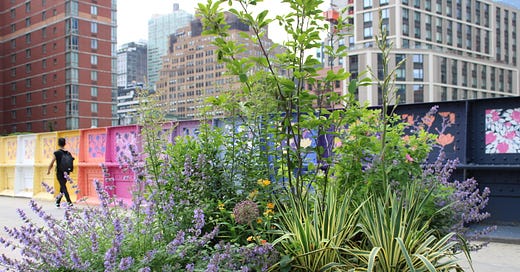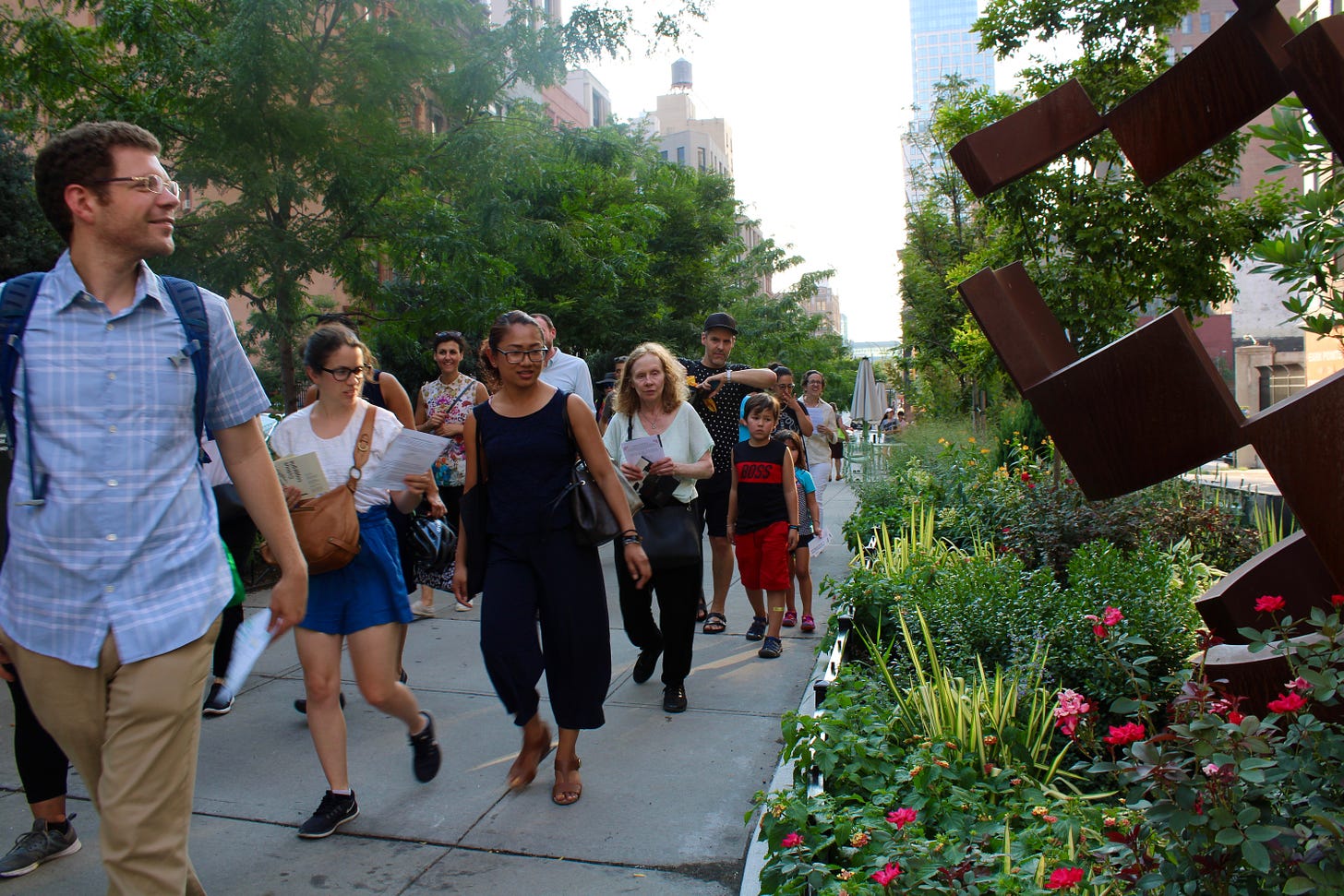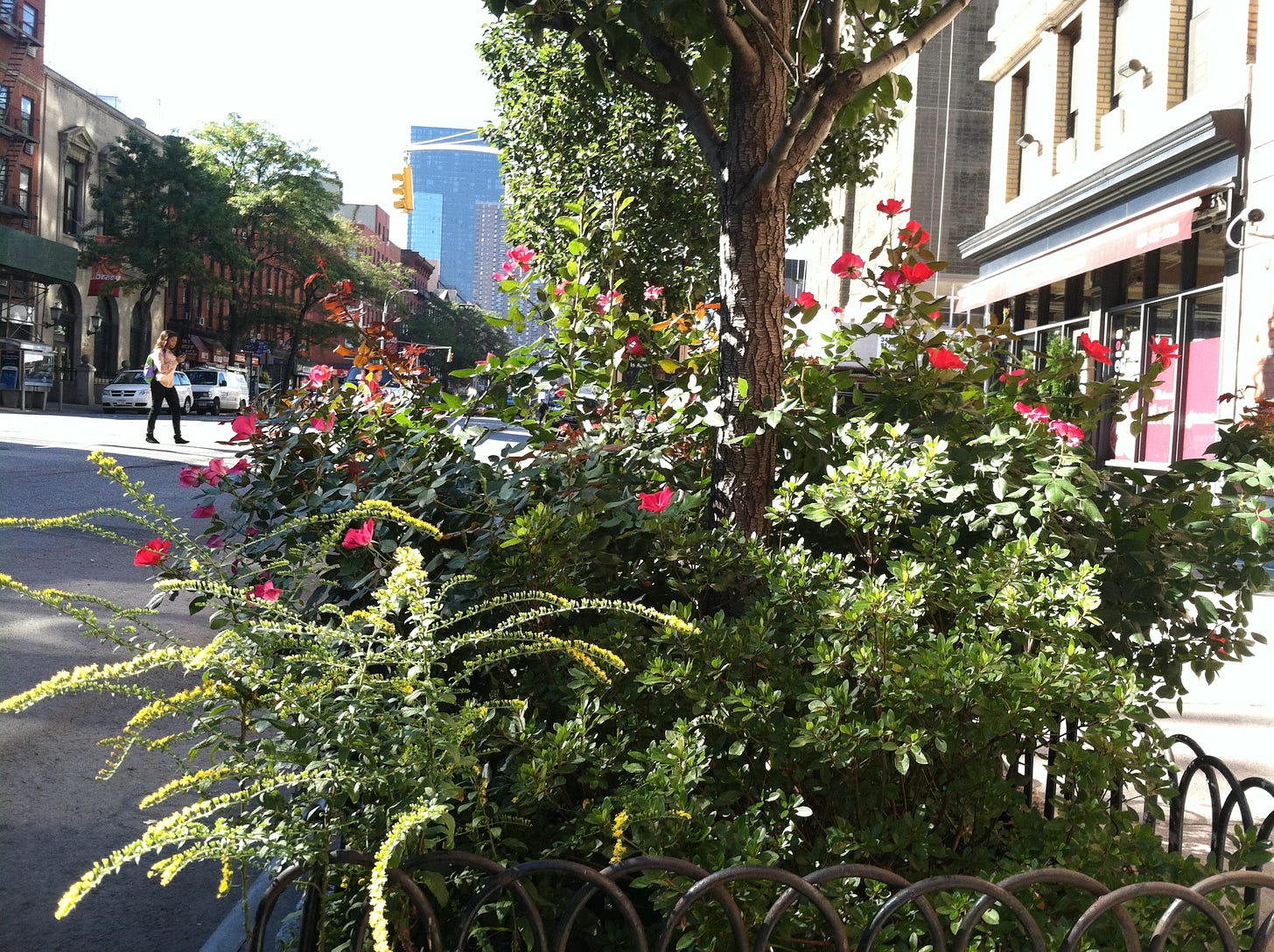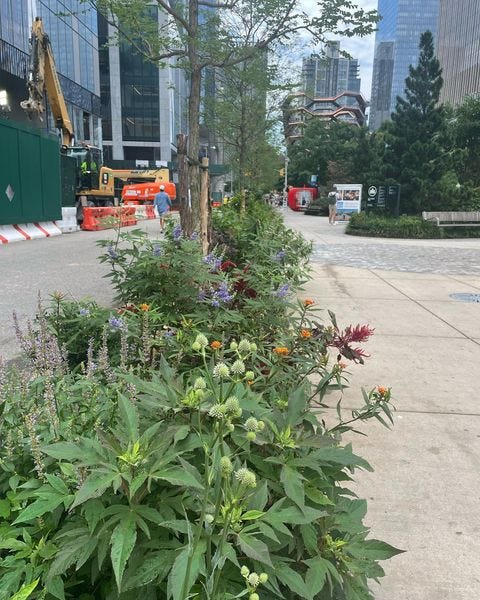Dreaming of sidewalk gardens and pocket prairies
Landscape designer Shanti Nagel, founder of Design Wild, talks about cultivating beauty and habitat in unexpected places
This newsletter is part of Living Small’s monthly Living Landscapes about sustainable gardening. Living Landscapes is becoming it’s own newsletter in 2024: Sign up here!
The avenue just north of my apartment has a median with trees running down its center. Since 2020, this stretch of city street has been closed to vehicular traffic during the day, and as a result, local gardeners have planted up a few blocks of the center strip–think small boxwood, hostas, and daffodils. Lately, I’ve been eyeing the bare dirt in the median closest to my own home and wondering, What if this could be a little garden too? And what if, instead of those non-native garden stalwarts it was planted with regional plants and pollinator favorites?
This is exactly what landscape designer Shanti Nagel, the principal of Design Wild, does with her “sidewalk gardens” and “pocket prairies.” So I reached out to Nagel to learn a little more about gardening in the streets of New York.
Nagel has been creating sidewalk gardens for more than a decade, mostly during her stint as the head gardener for a non-profit organization that builds affordable housing (a gig she landed after graduating from the New York Botanical Garden’s School of Professional Horticulture). “It was equal parts horticulture and community organizing,” she says. “I have a long and intergenerational background in civil action and organizing, so it was interesting to me.”
The director of the non-profit happened to be a gardener himself, and he challenged Nagel to plant the tree beds in front of buildings more like a perennial border than the usual tree-plus-annuals plantings. Nagel delivered, designing and maintaining a new style of sidewalk gardens before setting out to launch her own firm.
Today Nagel continues to work with the non-profit housing developer and also designs for private clients. Below Nagel shares how to cultivate the beauty and habitat in unexpected spaces:
Every bit counts
Even though a single sidewalk flower bed may not seem like much, “These little tiny pockets of ecology actually have an effect on insect life and songbird life,” Nagel says. And if a whole bunch of us get out there and garden the little squares of soil in front of our urban buildings, then a hundred (or a thousand!) individual flower beds add up to really meaningful habitat.
Start with the soil
“Our urban soil can be a lot of things–what we want is for it to be liveable,” says Nagel. The first step to get to know your soil is to test its pH, which you can do with a basic hardware store test (like this). But Nagel encourages city gardeners to go further and send their soil to a land-based university (in New York, you can do this through Cornell; it’ll cost you $50 for a soil fertility test that includes pH, organic matter, and heavy metals).
Plant native-ish
By gardening in the city, we have a chance to “create ecology,” says Nagel. But in order to do that we need to plant things that will benefit our local ecosystems. Nagel says that her garden designs are “about 80-percent native” at this point and she feels good about that ratio. It’s a similar ratio to what is recommended by the ⅔ for the Birds movement, which encourages gardeners to plant two native plants for every non-native plant.
Grow caterpillar food
To find a monarch butterfly is nice, says Nagel but they'll feed on lots of nectar from lots of plants; only butterfly weed can host Monarch caterpillars. “To find a caterpillar means that they're reproducing in your garden, so that's the real goal: to find caterpillars alive on your plantings,” she says. Nagel’s team has found caterpillars in the mouth of the Lincoln Tunnel. “There they are in these tiny meadows we've created in containers or just little street gardens. We can see evidence of the ecology actually working.”
Right location, right plant
Assess your location before choosing your plants. “You can probably guess from our name, Design Wild: I'm always trying to sort of emulate the natural world,” says Nagel. “I ask myself, “How close can we get to a natural environment for this plant–even though it's in the middle of traffic in midtown or in a container on a rooftop? Where is this plant happy in its own life, and how can we make it as close as possible to that environment for it.”
Design with layers
Whenever possible Nagel says she likes to design spaces with a tree, a shrub layer, a perennial layer, and a ground cover. “All of those actors can take their roles and, andgrow in harmony,” she says. “There's certainly some jockeying in there between plants, but eventually plants find their place and space to grow.”
Focus on perennials
When planting sidewalk gardens Nagel likes to include lots of perennials, which require less maintenance once established and will come back year after year. During the peak pandemic Nagel’s street gardens continued to bloom without anyone maintaining them. Below are four of her favorites that are also native to the Northeast.
PLANT PICKS:
Swamp milkweed (Asclepias incarnata) is very specific to the Monarch butterfly species.
Anise hyssop (Agastache foeniculum) “One of my absolute favorites, this member of the Mint family is just gorgeous and blooms all the time and the pollinators—butterflies, bees, all of them—love it.”
Goldenrod (Solidago sp.) “It’s a very common plant in the country, but in the city, it's that nod to wild meadows,” says Nagel. “I love a moment of goldenrod in the city—and pollinators love her.”
Switch grass (Panicum virgatum) This native ornamental grass is one that Nagel particularly loves.
Don’t forget the shrub layer
“Perennials are wonderful, but shrubs are even lower maintenance,” says Nagel, who relies heavily on shrubs in her sidewalk garden designs. “They'll just keep doing their thing for so long, they give structure to the garden. They're hearty in a different way than perennials. They take less weeding, for one.”
PLANT PICKS:
Sweet Bay Magnolia (Magnolia Virginiana) “Our native Magnolia is often evergreen throughout the winter in New York City,” says Nagel. “She has wonderful white flowers–nothing wildly showy, but I love her texture and foliage.”
American witch hazel (Hamamelis Virginiana) in appropriate places.
Serviceberry (Amelanchier arborea) Nagel describes this as lovely spring flowering native tree with edible berries that the birds (and humans) love to eat.
Highbush blueberry (Vaccinium corymbosum) “The birds get them first, but I love when people walk down the street and say, ‘Is that a blueberry?’ That's a fun moment of a human connecting with a plant,” says Nagel. She notes that blueberries are a beautiful shrub the rest of the year when they're not making berries and they have lovely flowers.
Inkberry (Ilex glabra) Nagel describes this small evergreen shrub similar in appearance to non-native boxwood as “a backbone of so many of my gardens.” Its berries, which persist through the winter, are important food for birds.
Weave in roses (yes, roses!)
“I came late to the rose game because they're so fussy, right? We have rose societies that have teas in rose gardens–that sort of thing never was my style,” says Nagel. “It didn’t fit into my sort of wild aesthetic. But the truth is that there are native roses that are tough as nails, and these ladies are not having tea in the rose garden: They are growing wild out in the prairies.” As Nagel points out, these plants have evolved a very effective defense mechanism (thorns) that is just as effective on the streets of a city as they would have been in the wild.
PLANT PICKS:
Prairie Rose (Rosa Virginiana) This pink petaled rose “is the very, very toughest” according to Nagel.
Pasture Rose (Rosa Carolina) This native rose “is a bit more of a lady,” growing to only about 3-feet tall.
Form a water brigade
“No plant can live without water, and no garden is no maintenance,” says Nagel. “If you don’t have irrigation, you need more humans.” For city street gardeners, this might mean organizing your neighbors to water the tree bed (kids can help!). Nagel also recommends reaching out to local supers, building staff, and business owners to help. “If we can get plants through the first couple years, especially with some water in those hottest months, then we have a wildly better chance of success.”
Feeling inspired? Follow Design Wild on Instagram (@designwildny). Shanti Nagel teaches a class in Urban Garden Maintenance at The Brooklyn Botanic Garden; the next session starts on June 2.
Further reading
If you are interested in learning more about native plants and why they are so important to our ecosystems, check out the work of Doug Tallamy, an entomologist who has written several books on the subject; I’d start with Bringing Nature Home. He also founded a non-profit Homegrown National Park that offers resources for home gardeners making the switch to native plants.
You can grow vegetables in the city street too! Before his TED Talk and his Master Class, Ron Finley was an everyday citizen vegetable gardening on the streets of Los Angeles–and when a neighbor complained about it, Finley and his community organized to make it legal for citizens to plant vegetables in front of their homes.
Richard Reynolds is leader in the “guerilla gardening” movement (guerrillagardening.org). He describes having his more recent urban garden featured in the pages of Gardens Illustrated as “vindication” for the guerilla gardeners like himself. We are in the midst of Wildflower Fortnite (May 1-14) in which we are encouraged to “see the city” with sunflowers.
I love this account dedicated to documenting the organizers’ care for New York City’s trees.
Writing
Here are a few things I have written lately that I thought LIVING SMALL readers might enjoy:
How to Limewash Paint Your Walls (RealSimple.com)
How to Fake a Custom Closet—Without a Major Renovation (RealSimple.com)
10 Ways to Make a Tiny Kitchen Work for You (Home52)
This One-Piece Is the ‘Mom’ Swimsuit of My Dreams (WSJ Buy Side)
Also: The Bunk Bed Book celebrated its one-year publication anniversary yesterday!
Reading
Sharing the dreamy small-ish houses I have bookmarked lately:
A Designer Couple Weave Fresh Elements Into a 107-Year-Old Kyoto Townhouse (also @dwellmagazine Instagram)
Anawhata House by Paul Davidson
One last thing! I am late to the party, but how gorgeous is THIS? I am going to try to recreate it.










I love all of this. After working to transition my yard to mostly prairie natives, it is hums with life in a completely different way then it did just two years ago. I am going to start calling it a "pocket prairie." That's perfect. This prairie girl would have loved a NYC sized pocket prairie when she lived there!
This is very inspiring. Thank you to you and Shanti for so much practical info!